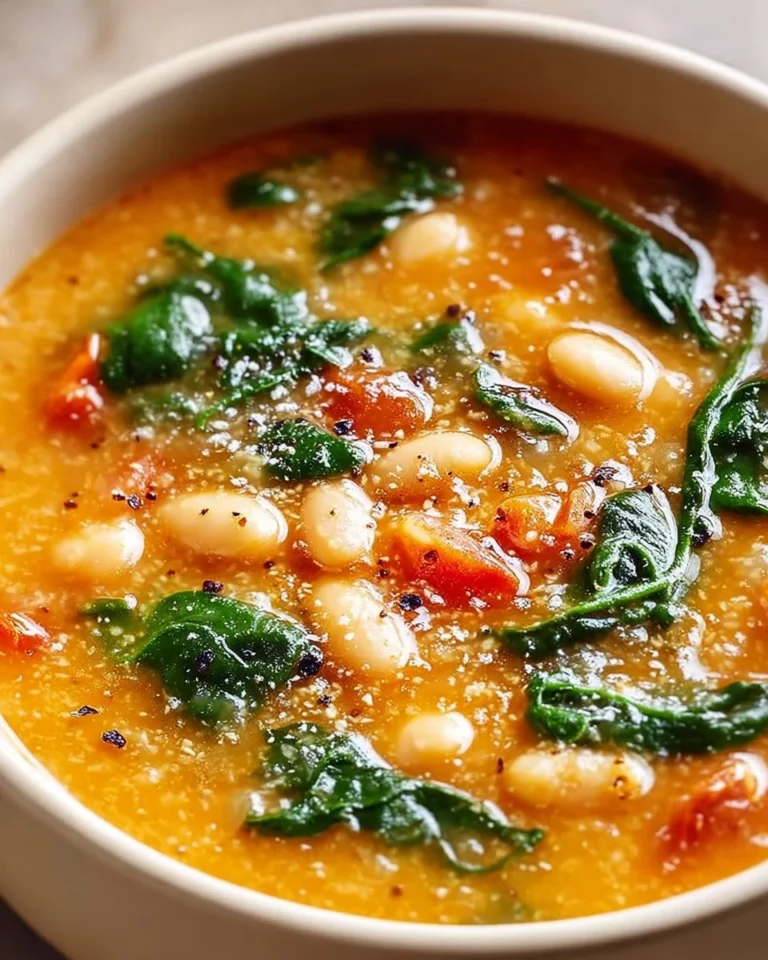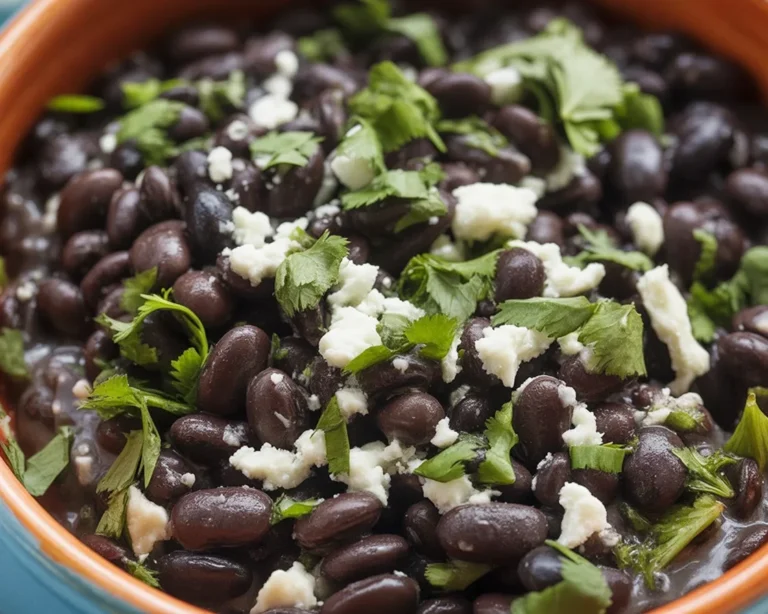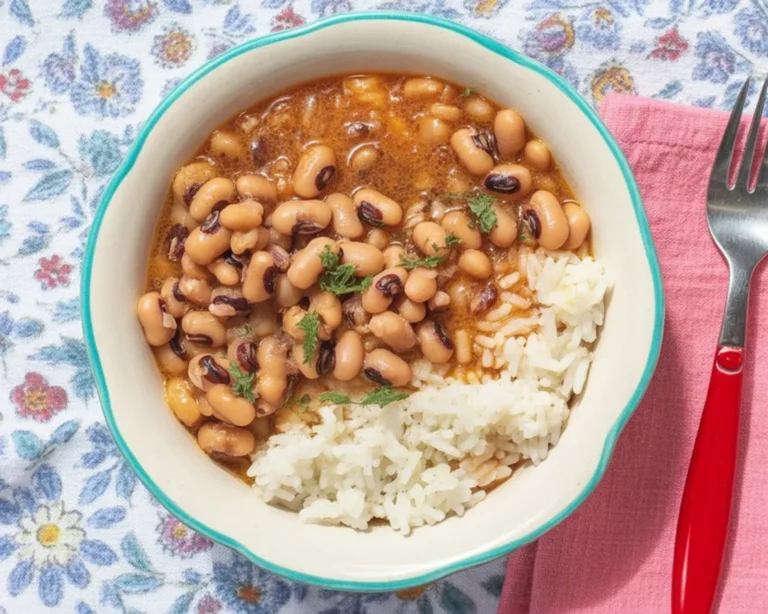Imagine dipping your favorite pita chips into a creamy, tangy, and delicious dip. You can make this right in your kitchen. You’re about to learn how to make an easy homemade hummus recipe that will be a favorite in your home.
Making homemade mediterranean hummus is easy. It’s a great way to enjoy a healthy snack or appetizer with loved ones. With just a few ingredients, you can make a dish that’s both tasty and good for you.
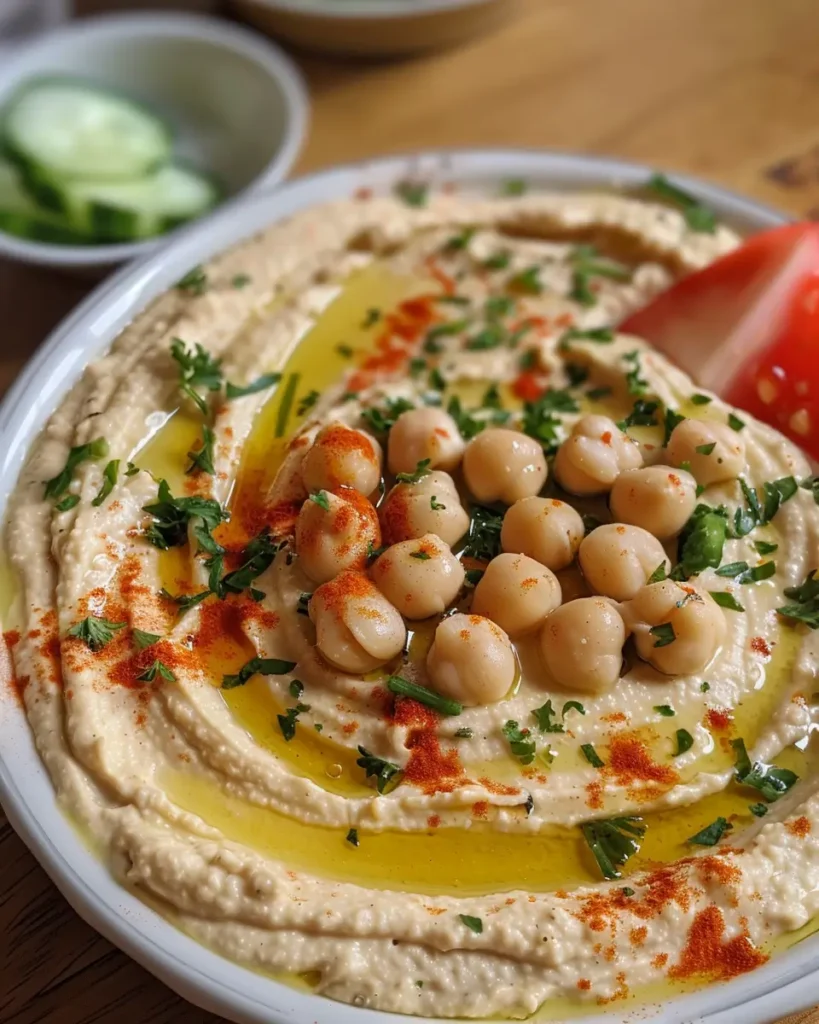
In this article, we’ll show you how to make a delicious hummus mediterranean recipe. You’ll learn how to prepare this tasty dip. Plus, you’ll get tips on how to make it your own.
Table of Contents
Key Takeaways
- Learn how to make a simple and delicious homemade hummus recipe
- Discover the essential ingredients for making mediterranean hummus
- Get tips on customizing your hummus to suit your taste preferences
- Understand the health benefits of enjoying hummus as a snack or appetizer
- Find out how to serve and store your homemade hummus
The Rich Heritage of Mediterranean Hummus
Mediterranean hummus comes from the Middle East and is loved worldwide. It’s enjoyed by people from many cultures. This tasty dip has a long history, spanning centuries.
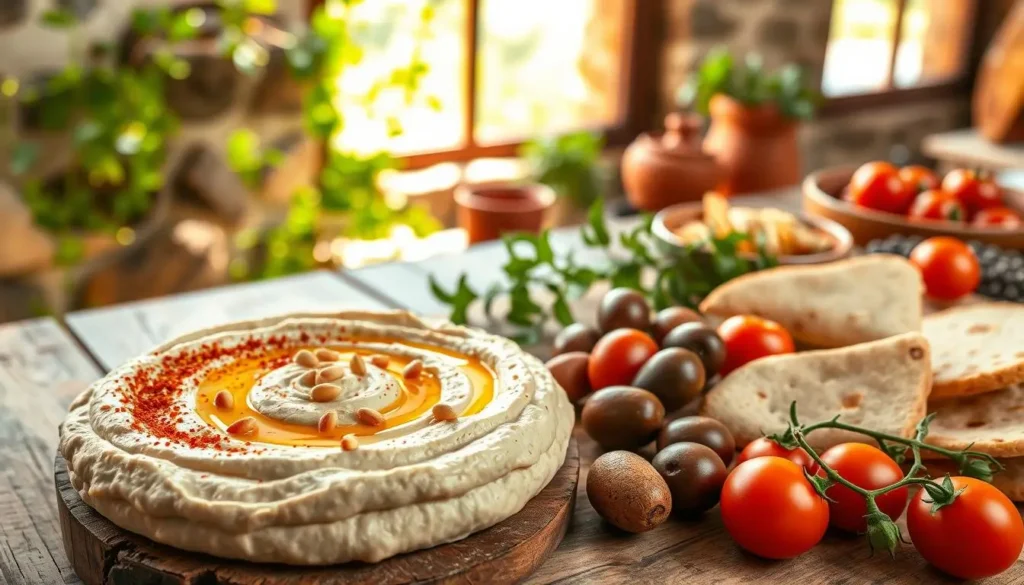
Origins and Cultural Significance
Hummus started in the Middle East and has been a favorite for centuries. It’s a big part of Mediterranean cuisine, with each culture adding its own twist. You can see how hummus is made and enjoyed in different Mediterranean places.
Hummus is more than just food. It’s a sign of welcome in many Mediterranean cultures. Making and sharing hummus brings people together, creating a sense of community.
Key aspects of hummus’ cultural significance include:
- Traditional serving methods
- Regional variations in ingredients and preparation
- Role in social and family gatherings
Traditional vs. Modern Variations
Hummus has changed over time, leading to many traditional and modern versions. You can find different hummus types across the Mediterranean, each with its own special touch. Traditional hummus stays true to the original, while modern versions try new ingredients and flavors.
Some popular variations include:
- Roasted red pepper hummus
- Spicy hummus with added chili peppers
- Herb-infused hummus with fresh parsley or cilantro
These variations show how versatile hummus is. It can be made in many ways to suit different tastes. You can try different ingredients to make your own unique hummus.
Essential Ingredients for Authentic Hummus Mediterranean
The secret to amazing hummus is in its ingredients. To make homemade hummus with tahini that’s as good as store-bought, start with the best ingredients. Knowing how each part adds to the taste is key for a true olive hummus recipe homemade.
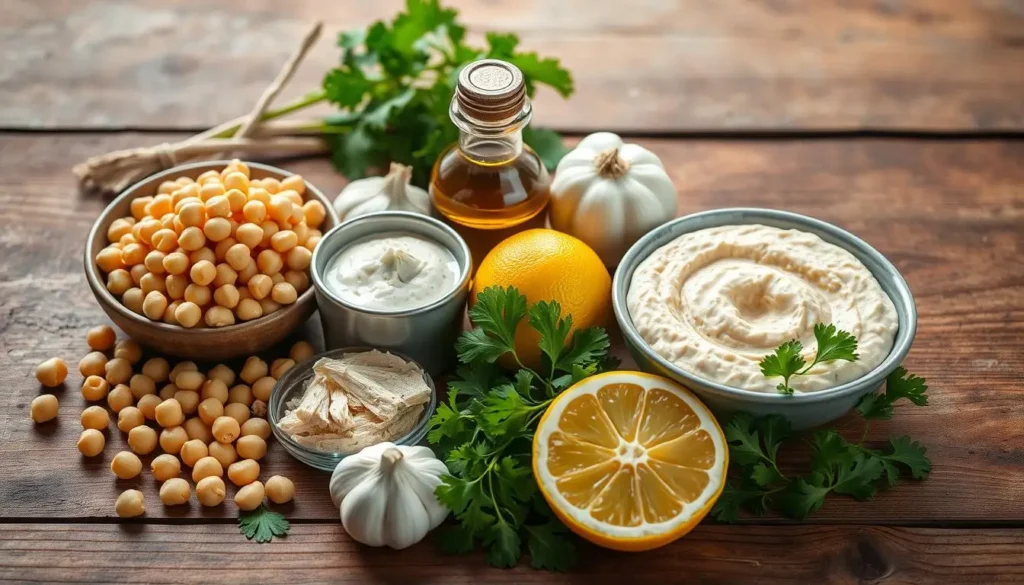
Selecting the Perfect Chickpeas
Chickpeas are hummus’s main ingredient. You can pick canned or dried chickpeas, but quality matters. For the best taste, go for high-quality canned chickpeas or cook dried ones from scratch.
If you cook dried chickpeas, soak them overnight first. Then, simmer them until they’re soft. This step can make your hummus taste and feel better.
The Role of Tahini in Mediterranean Hummus
Tahini is vital for hummus’s nutty taste and creamy feel. Choose a smooth, high-quality tahini. Some tahinis taste stronger than others, so taste before adding it. Keep tahini in a sealed container in the fridge to avoid rancidity.
Olive Oil Selection Tips
Olive oil makes hummus richer and helps with its texture. For a real make hummus recipes experience, use extra virgin olive oil. The right olive oil can change your hummus’s taste, so pick one that goes well with the other ingredients.
Fresh Herbs and Spices
Fresh herbs like parsley, cilantro, or garlic can make your hummus taste better. Spices like cumin or paprika add more depth. Try different mixes to find your favorite flavor. The secret to great hummus is finding the right balance, so don’t overdo it with too many flavors.
Equipment You’ll Need
Starting your hummus journey begins with the right kitchen tools. Making great hummus is easy with the right equipment. Let’s look at what you’ll need to begin.
Food Processor vs. Blender Options
For hummus, you’ll need a food processor or blender. Both can make excellent hummus, but they differ.
| Feature | Food Processor | Blender |
|---|---|---|
| Texture | Provides a smoother texture with less effort | Can produce a smooth texture but may require more stopping and scraping |
| Capacity | Generally has a larger capacity, ideal for bigger batches | Suitable for smaller batches or when blending other ingredients |
| Ease of Use | Easier to use for thick mixtures like hummus | May require more liquid to blend efficiently |
Both food processors and blenders can make great hummus. Your choice depends on what you have or your needs.
Additional Kitchen Tools
There are more tools to help with making hummus.
- A pot for cooking chickpeas if you’re using dried ones
- A utensil or a method for removing chickpea skins for a smoother hummus
- A lemon squeezer for fresh lemon juice
- A garlic press for mincing garlic
These tools can make making hummus easier and better.
With the right tools, you’re ready to make delicious hummus. You can use a food processor or blender. And with extra tools, you can try different recipes, like an easy homemade hummus recipe or a whipped hummus recipe.
Preparing Your Chickpeas
The foundation of great hummus lies in its chickpeas, and preparing them correctly is key. Whether you’re using dried or canned chickpeas, the quality of your hummus depends on this initial step.
Dried vs. Canned: Pros and Cons
When making homemade Mediterranean hummus, you’ll face a choice: dried or canned chickpeas. Both have their good and bad sides.
- Dried Chickpeas: Cooking dried chickpeas from scratch makes for a creamier hummus. But, it takes more time and planning.
- Canned Chickpeas: Canned chickpeas are quick and easy, saving you time. Yet, they might have more sodium and a less creamy texture.
| Chickpea Type | Pros | Cons |
|---|---|---|
| Dried | Creamier hummus, control over sodium | More time-consuming, requires soaking and cooking |
| Canned | Convenient, saves time | May contain more sodium, potentially less creamy hummus |
Soaking and Cooking Dried Chickpeas
If you choose dried chickpeas for your make hummus recipes, follow these steps:
- Rinse the dried chickpeas well.
- Soak them in water for at least 8 hours or overnight.
- Drain and rinse the chickpeas again, then place them in a large pot covered with water.
- Bring to a boil, then reduce the heat and simmer until the chickpeas are tender.
By following these steps, you’ll be well on your way to creating delicious homemade Mediterranean hummus that will impress your family and friends.
Step-by-Step Hummus Mediterranean Recipe
Now that you have the ingredients and tools, let’s start making the Hummus Mediterranean. This guide will help you make a tasty and true-to-recipe hummus.
Basic Ingredients List
To make classic hummus, you’ll need these ingredients:
- 1 cup chickpeas (garbanzo beans)
- 1/4 cup tahini
- 1/4 cup freshly squeezed lemon juice
- 1 minced garlic clove
- 1/4 cup olive oil
- Salt, to taste
- Optional: paprika, parsley, or other herbs for garnish
Preparation Method
Making hummus Mediterranean is easy:
Step1: Preparing Your Base
Drain and rinse the chickpeas. If using canned, save some liquid for later.
Step2: Adding Core Ingredients
In a food processor, mix the chickpeas, tahini, lemon juice, and garlic. Keep processing until it’s smooth and creamy.
Step3: Blending Techniques
With the processor running, add the olive oil slowly. Keep blending until it’s the right consistency. You might need to stop and scrape the sides a few times.
Step4: Final Adjustments
Taste and adjust the seasoning as needed. If it’s too thick, add some chickpea liquid or water. If it’s too thin, add more tahini or chickpeas.
Troubleshooting Common Issues
Even with a simple recipe like hummus Mediterranean, problems can happen. Here are some common issues and how to fix them:
| Issue | Solution |
|---|---|
| Hummus too thick | Add a little water or reserved chickpea liquid |
| Hummus too thin | Add more tahini or chickpeas |
| Lack of flavor | Adjust seasoning, add more lemon juice or garlic |
By following these steps and tips, you’ll make a delicious and authentic hummus Mediterranean. It’s sure to impress.
Secrets to Ultra-Creamy Whipped Hummus
Creating the creamiest hummus involves a few key steps. Getting the right texture makes all the difference. We’ll look at what makes whipped hummus so smooth and creamy.
The Importance of Removing Chickpea Skins
Removing chickpea skins is a big step towards a smoother hummus. Skins can make hummus grainy, which isn’t what we want. By taking them off, you get a smooth and velvety texture.
To remove the skins, follow these steps:
- Boil the chickpeas with a pinch of baking soda to loosen the skins.
- Drain and rinse the chickpeas, then rub them gently between your fingers or with a towel to remove the skins.
- Rinse the chickpeas again to remove any remaining skins.
Temperature and Timing Considerations
The temperature and blending time of your ingredients are also important. Blending at the right temperature can greatly affect the creaminess. Cold ingredients make for a thicker, creamier hummus.
Blending time is also key. Too long and it gets too thin, too short and it’s chunky. Here’s a simple guide:
- Blend the ingredients on high speed for about 2 minutes.
- Stop and scrape down the sides of the blender or food processor.
- Continue blending for another minute or until you achieve the desired consistency.
Authentic Hummus Mediterranean Variations
Exploring the authentic variations of hummus shows the rich culinary diversity of the Mediterranean. Different cultures in this region have their own unique takes on this classic dip. They use local flavors and ingredients.
Greek-Style Hummus
Greek hummus often includes feta cheese and kalamata olives. This gives it a distinct flavor. Fresh herbs like parsley or oregano add a bright, fresh taste.
Lebanese Hummus Variations
In Lebanon, hummus is topped with a generous amount of pine nuts. This adds a crunchy texture and nutty flavor. Some recipes also include a hint of sumac for its tangy taste.
Turkish Hummus Approach
Turkish hummus, or “Humus,” is similar to others but seasoned with paprika. It’s sometimes served with a sprinkle of red pepper flakes for heat.
Persian-Inspired Hummus Recipes
Persian-inspired hummus recipes might include barberries or pomegranate molasses. These add a sweet and tangy twist. They reflect the rich culinary heritage of Persia.
| Variation | Key Ingredients | Unique Flavor Profile |
|---|---|---|
| Greek-Style | Feta cheese, kalamata olives | Salty, savory |
| Lebanese | Pine nuts, sumac | Nutty, tangy |
| Turkish | Paprika, red pepper flakes | Smoky, spicy |
| Persian-Inspired | Barberries, pomegranate molasses | Sweet, tangy |
These variations show how versatile hummus is. Different cultures add their own twist to this classic dish. It’s a fascinating dip to explore for anyone interested in Mediterranean cuisine.
Creative Flavor Additions
Make the classic hummus recipe your own with bold and refreshing flavors. You can create unique and delicious hummus by adding different ingredients. This way, you can enjoy new and tasty variations.
Roasted Red Pepper Hummus
Roasted Red Pepper Hummus is a favorite among many. It gets its sweet and smoky taste from roasted red peppers. To make it, roast red peppers until charred, then blend them with chickpeas, tahini, garlic, and lemon juice.
Olive Hummus Recipe Homemade
Try an Olive Hummus Recipe Homemade for a savory twist. This hummus gets its salty, umami flavor from pitted green or black olives. You can also mix in artichoke hearts or sun-dried tomatoes for extra depth.
- Use pitted green or black olives for the best flavor.
- Experiment with different types of olives to find your favorite.
- Combine olives with other ingredients for a unique taste.
Herb-Infused Variations
Herb-Infused Variations bring a fresh and exciting twist to hummus. Adding fresh or dried herbs like parsley, cilantro, or dill creates a hummus that complements many dishes. For instance, parsley and garlic hummus goes well with grilled meats, while cilantro and lime hummus is great for Mexican dishes.
For more unique hummus flavors, check out this page for inspiration.
Serving Your Homemade Mediterranean Hummus
Your homemade hummus Mediterranean is ready to be served. We’re here to guide you through the best ways to do so. Serving hummus is not just about placing it on a plate. It’s about creating an inviting experience for your guests.
Traditional Presentation Techniques
Traditionally, hummus Mediterranean is served in a shallow bowl. It’s drizzled with olive oil and garnished with paprika, parsley, or chickpeas. You can also create a pattern with your olive oil or add a sprinkle of sumac for extra flavor and color.
Accompaniment Suggestions
Hummus is typically served with pita bread or vegetables. You can also use it as a dip or a spread in sandwiches. Here are some popular accompaniments:
| Accompaniment | Description |
|---|---|
| Pita Bread | Classic combination, perfect for dipping. |
| Vegetables | Carrots, cucumbers, and bell peppers make great dippers. |
| Grilled Meats | Serve hummus alongside grilled meats for a hearty snack. |
Experiment with different mediterranean dip recipes hummus by incorporating various accompaniments. Find your favorite combinations.
Mediterranean Dip Recipes to Complement Your Hummus
The Mediterranean offers many dips beyond hummus. These dips add variety to your mezze platter. They bring unique flavors and textures that pair well with hummus.
Let’s explore some of these delicious Mediterranean dips:
- Baba Ganoush: A smoky eggplant dip that’s rich and creamy.
- Tzatziki: A refreshing yogurt-based dip with cucumber and garlic.
- Muhammara: A spicy dip made from roasted red peppers and walnuts.
Baba Ganoush
Baba Ganoush is a favorite Mediterranean dip. It’s made from roasted eggplants. Roast the eggplants until charred, then blend with tahini, garlic, lemon juice, and olive oil.
This dip is smoky, creamy, and utterly delicious. Enjoy it with pita bread or vegetables for a tasty snack.
Tzatziki
Tzatziki is a cool and refreshing dip for hot days. It’s made with yogurt, cucumber, garlic, and dill. Use thick, strained yogurt and remove excess water from the cucumber.
This dip is great with grilled meats or as a dip for vegetables. Add a sprinkle of paprika or a squeeze of lemon juice for a twist.
Muhammara
Muhammara is a spicy and flavorful dip from Syria. It’s made with roasted red peppers, walnuts, garlic, and breadcrumbs. Blend with olive oil and lemon juice.
This dip is not only delicious but also packed with nutrients. Serve it as a dip or as a sauce for grilled meats. For more inspiration, check out this three-layer Mediterranean hummus dip recipe.
These Mediterranean dips offer a range of flavors and textures. They can elevate your snacking game. Whether you’re hosting a party or just looking for a healthy snack, these dips are sure to impress.
Storing and Preserving Your Homemade Hummus
Keeping your homemade hummus fresh is important. After making your delicious homemade Mediterranean hummus, you’ll want it to last as long as possible.
To keep it fresh, follow the right storage tips. You can store your hummus in the fridge or freezer. Each method has its own best practices.
Refrigeration Best Practices
For fridge storage, use an airtight container. This keeps it from picking up odors from other foods. It can stay fresh for 3 to 5 days in the fridge. Before eating, stir it well and adjust the seasoning if needed.
- Use a clean spoon each time you serve to prevent contamination.
- Keep it away from strong-smelling foods like garlic and onions.
- If you notice any signs of spoilage, such as an off smell or mold, discard it immediately.
Freezing Options
To keep it longer, you can freeze your homemade hummus. Put it in an airtight container or freezer-safe bag, leaving space for expansion. Frozen hummus can last up to 6 months. Thaw it overnight in the fridge and stir well before serving.
- Label the container with the date so you can keep track of how long it’s been stored.
- When thawing, if the hummus seems too thick, you can adjust the consistency with a little water or lemon juice.
By following these storage tips, you can enjoy your homemade Mediterranean hummus for a longer period. It will stay fresh and flavorful.
Conclusion
Now that you’ve learned about hummus Mediterranean, it’s time to try making it at home. Making homemade Mediterranean hummus is easy and fun. You can play with different flavors and ingredients.
Follow the steps in this article to make a tasty and authentic hummus Mediterranean. It’s sure to wow your family and friends.
Don’t be afraid to try new things, like roasted red pepper or olive hummus. Pair it with various dips and sides. Hummus is a versatile and delicious addition to any meal. So, give it a go and enjoy the Mediterranean flavors in your own kitchen.
FAQ
What is the best way to make homemade Mediterranean hummus?
To make homemade Mediterranean hummus, mix chickpeas, tahini, garlic, lemon juice, and olive oil in a food processor or blender. Blend until it’s smooth. Adjust the seasoning to your liking.
Can I use canned chickpeas for hummus?
Yes, canned chickpeas work for hummus. But cooking dried chickpeas gives a more authentic taste and texture. If using canned, drain and rinse them well.
How do I achieve ultra-creamy hummus?
For ultra-creamy hummus, remove chickpea skins and use top-quality tahini. Blend well for a long time. Adding a bit of water or lemon juice helps with consistency.
What are some creative ways to flavor my hummus?
You can add roasted red peppers, olives, parsley, or cilantro to your hummus. Try different spices like cumin or paprika. Find your favorite mix.
How should I store homemade hummus?
Keep homemade hummus in an airtight container in the fridge. It lasts up to a week or can be frozen for 3 months. Thaw it in the fridge or at room temperature when frozen.
Can I make hummus without tahini?
Yes, you can make hummus without tahini. But tahini adds a rich, nutty flavor and creamy texture.
What are some Mediterranean dip recipes that complement hummus?
Try baba ganoush, tzatziki, and muhammara with hummus. These dips offer different flavors and textures.
How do I serve homemade Mediterranean hummus?
Serve homemade Mediterranean hummus with pita bread, veggies, or crackers. Add olive oil, paprika, or parsley for a traditional look.
Can I make whipped hummus?
Yes, whip hummus by blending chickpeas, tahini, garlic, and lemon juice until light and airy. Add water or olive oil for the right consistency.
Are there any variations of hummus recipes?
Yes, there are many hummus variations, like Greek, Lebanese, Turkish, and Persian. Try different ingredients and spices to create your own.

Mediterranean Hummus
Ingredients
Main Ingredients
- 1 cup chickpeas (garbanzo beans) Use canned or dried, soaked overnight and cooked.
- ¼ cup tahini Choose high-quality tahini for best flavor.
- ¼ cup freshly squeezed lemon juice Use about 1-2 lemons, depending on size.
- 1 clove garlic Minced for better flavor.
- ¼ cup olive oil Extra virgin olive oil works best.
- to taste salt
- optional paprika, parsley, or other herbs for garnish Enhance presentation and flavor.
Instructions
Preparation
- Drain and rinse the chickpeas. If using canned, save some liquid for later.
Ingredients Mixing
- In a food processor, mix the chickpeas, tahini, lemon juice, and minced garlic. Process until smooth and creamy.
Blending Techniques
- With the processor running, add the olive oil slowly. Continue blending until the desired consistency is reached, stopping to scrape down the sides as necessary.
Final Adjustments
- Taste and adjust the seasoning as needed. If too thick, add chickpea liquid or water. If too thin, add more tahini or chickpeas.
